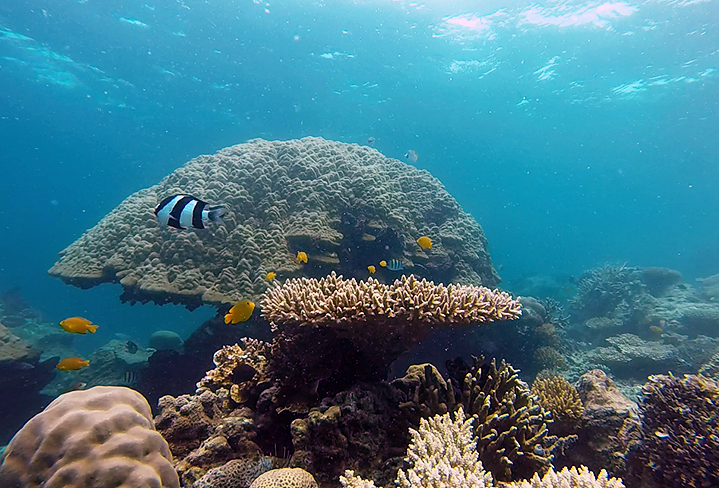Fish Also Keep Watch

Damselfish of the genus Pomacentrus swarm around a branch coral, Indonesia Photo: Robin Gauff, Leibniz Centre for Tropical Marine Research
In the damselfish genus, there are species that live in close proximity to branching stone corals. They swarm around them and seek shelter between their branches as soon as danger threatens. The corals also benefit from their subtenants.
Through their fanning behaviour, the damselfish ensure better water circulation as well as the supply and removal of oxygen. Hence, corals that live in a mutualistic relationship with damselfish can grow much faster.
Dr Sebastian Ferse, reef ecologist at the ZMT, and his team wanted to more closely investigate this symbiosis in lemon damselfish, shoal-forming reef fish of the species Pomacentrus moluccensis. They observed that the large, adult damselfish behave differently than the smaller, juvenile fish in case of danger.
In the area of the “Thousand Islands”, which belongs to Indonesia, the researchers used underwater cameras in four different locations to film stone corals where reef fish were sheltering. In addition, they laid out pieces of dried squid as bait to attract predatory fish and also studied other factors that could threaten the damselfish.
The evaluation of the video material revealed that the fish perceived certain situations as particularly dangerous. The juvenile fish in particular disappeared deeper into the coral when the water was turbid and approaching predators such as snappers, groupers or angel fish could not be spotted immediately. While predators were close by, the adult fish positioned themselves relatively far away from the coral.
“With this behaviour, the larger lemon damselfish can better perceive their enemies. When a predator approaches, they pull back into the coral at lightning speed. As a result, they warn their inexperienced, smaller conspecifics,” said Sebastian Ferse. The young fish sense the retreat of the big fish via their lateral line organ, with which they register water movements. The “sentinel fish” may also give alarm cues, as has already been proven with clownfish.
“Such selfless behaviour can only be explained by the fact that the members of a group are closely related,” said Ferse. When reef fish spawn, the water flow drives the larvae away. However, the young damselfish have an amazing ability to find their way back to their original host coral. Thus, there may be close family ties between the inhabitants of a coral. Here molecular genetic investigations can provide information about the relationships.
Publication
Robin P.M.Gauff, Sonia Bejarano, Hawis H. Madduppa, Beginer Subhan, Elyne M.A. Dugény, Yuda A. Perdana, Sebastian C.A. Ferse: Influence of predation risk on the sheltering behaviour of the coral-dwelling damselfish, Pomacentrus moluccensis. Environmental Biology of Fishes (2018).
Contact
Dr. Sebastian Ferse
Leibniz Centre for Tropical Marine Research
email: sebastian.ferse@leibniz-zmt.de
Phone: +49 ()421 / 23800 – 28
About the Leibniz Centre for Tropical Marine Research
In research and education the Leibniz Centre for Tropical Marine Research (ZMT) in Bremen is dedicated to the better understanding of tropical coastal ecosystems. As an interdisciplinary Leibniz institute the ZMT conducts research on the structure and functioning of tropical coastal ecosystems and their reaction to natural changes and human interactions. It aims to provide a scientific basis for the protection and sustainable use of these ecosystems. The ZMT works in close cooperation with partners in the tropics, where it supports capacity building and the development of infrastructures in the area of sustainable coastal zone management. The ZMT is a member of the Leibniz Association.
Media Contact
More Information:
http://www.leibniz-zmt.deAll latest news from the category: Life Sciences and Chemistry
Articles and reports from the Life Sciences and chemistry area deal with applied and basic research into modern biology, chemistry and human medicine.
Valuable information can be found on a range of life sciences fields including bacteriology, biochemistry, bionics, bioinformatics, biophysics, biotechnology, genetics, geobotany, human biology, marine biology, microbiology, molecular biology, cellular biology, zoology, bioinorganic chemistry, microchemistry and environmental chemistry.
Newest articles

NASA: Mystery of life’s handedness deepens
The mystery of why life uses molecules with specific orientations has deepened with a NASA-funded discovery that RNA — a key molecule thought to have potentially held the instructions for…

What are the effects of historic lithium mining on water quality?
Study reveals low levels of common contaminants but high levels of other elements in waters associated with an abandoned lithium mine. Lithium ore and mining waste from a historic lithium…

Quantum-inspired design boosts efficiency of heat-to-electricity conversion
Rice engineers take unconventional route to improving thermophotovoltaic systems. Researchers at Rice University have found a new way to improve a key element of thermophotovoltaic (TPV) systems, which convert heat…



